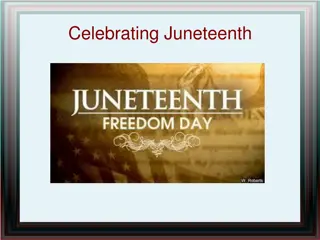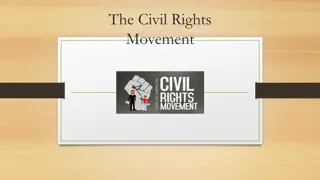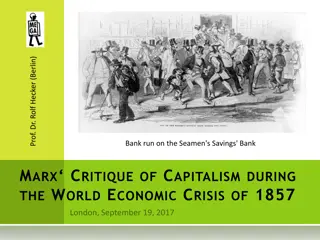Examining Water Imagery in Toni Morrison's "Beloved" and Its Contextualization with Historical Events
Toni Morrison skillfully evokes the harrowing Middle Passage experience in "Beloved" through water imagery, symbolizing themes of cleansing, rebirth, and trauma. By comparing the water symbolism at various points in the novel, readers can explore its significance in relation to historical events lik
6 views • 14 slides
Understanding Juneteenth: A Celebration of Freedom and Resilience
Juneteenth, short for June 19, marks the end of slavery in the US and celebrates the emancipation of enslaved people in Texas in 1865. This holiday honors African Americans' fight for freedom and highlights resilience, progress, family bonds, and the joy of life. Explore the historical significance
1 views • 14 slides
Understanding Juneteenth: An Overview of Historical Significance
Juneteenth, celebrated on June 19th, marks the end of slavery in the United States in 1865. Initially met with resistance, it has seen a resurgence, especially during the Civil Rights movement. It is not the same as Emancipation Day. Learn about its history and importance today.
0 views • 11 slides
The Civil Rights Movement: Struggles and Triumphs
Abolitionists fought against slavery, leading to the Emancipation Proclamation during the Civil War. Early protests against Jim Crow laws laid the foundation for organizations like the NAACP. Key events, such as Rosa Parks' arrest and the Civil Rights Act of 1964, marked significant progress. The Vo
0 views • 7 slides
Emancipation of Serfs in Russia: Causes and Consequences
The Emancipation of Serfs in Russia in 1861 marked a significant transformation in society. Influenced by various factors such as the Crimean War, pressure from nobles and intellectuals, growing peasant uprisings, and economic motives, Tsar Alexander II abolished serfdom. This decision aimed to alle
3 views • 11 slides
Exploring the Civil War Era and the Fight for Freedom Through Images
Explore the visual journey of the Civil War era, including key figures, events, and symbols such as the Underground Railroad, Emancipation Proclamation, and Reconstruction period. Delve into the struggles and triumphs of individuals fighting for freedom and equality during this transformative period
0 views • 29 slides
Analyzing Frederick Douglass' Perspective on Emancipation Process in the US
Explore Frederick Douglass' critical view on the emancipation of slaves by the US government through Document 2, highlighting the challenges faced by the freedmen and the repercussions of the process. Delve into model answers and scholar insights to comprehend the historical context and complexities
0 views • 12 slides
Unraveling Nelson Mandela's Legacy: Lessons in Leadership and Resilience
Delve into the life of Nelson Mandela, a beacon of hope and perseverance, who transitioned South Africa from apartheid to democracy. Explore his unwavering commitment to justice and emancipation, reflecting on his enduring legacy of peace and reconciliation worldwide.
0 views • 14 slides
Understanding the Feudal System: Lords, Serfs, and Hierarchy
The Feudal System was a social hierarchy where the king held control, and peasants did the work at the bottom. Lords owned the land while serfs worked on it. Explore the differences between a lord and a serf, how the system provided order and stability, and the new form introduced in England. Join a
1 views • 5 slides
Texas Frontier Wars: A Historical Overview
Explore the conflict and interactions between Native Americans and Anglo-Americans in Texas through key events like the Civil War, Emancipation Proclamation, and the influence of important figures like Kiowa Chief Sitting Bear and Comanche Chief Quanah Parker.
0 views • 16 slides
History of Public Health Insurance in the US: Understanding Federal Expenditure Before 1900
Explore the historical development of public health insurance in the US, focusing on federal expenditure before 1900. Topics covered include Civil War implications, Freedmen's Bureau, pensions, mutual aid organizations, and early welfare states. The narrative delves into the Civil War era, internal
0 views • 83 slides
Twin Victories in the Rise of the Confederacy: Fredericksburg and Chancellorsville
The Civil War in late 1862 saw pivotal moments as the Union faced setbacks at Fredericksburg and Chancellorsville. After the Battle of Antietam, President Lincoln's Emancipation Proclamation set the stage for a shifting tide. The Union's struggles at Fredericksburg under Burnside led to Hooker's uns
0 views • 10 slides
Impact of the Civil War on Georgia: Roles and Key Events
Georgia played a significant role in the Civil War, facing the Union blockade, experiencing the effects of the Emancipation Proclamation, engaging in battles like Chickamauga, being part of Sherman's Atlanta Campaign and March to the Sea, and hosting the infamous Andersonville prison. The state's in
0 views • 20 slides
The Civil War: Key Events and Battles Overview
Explore the causes, events, and significant battles of the Civil War, from the disagreements over tariffs, slavery, sectionalism, and states' rights to pivotal moments like Lincoln's presidency, secession, the Emancipation Proclamation, and decisive battles at Gettysburg and Vicksburg. Witness the s
0 views • 9 slides
Marx's Critique of Capitalism During the 1857 World Economic Crisis
In 1857, amidst a world economic crisis, Karl Marx worked tirelessly on his economic manuscript, the Grundrisse, focusing on the political economy outlines and the current crisis. He aimed to create a pamphlet to remind the German public of his presence. Marx identified France as a potential site fo
0 views • 13 slides
Reflections on Segregation and Freedom: A Poetic Perspective
Langston Hughes' poem "Long View: Negro" delves into the contrasting perspectives of emancipation and segregation, using the analogy of a telescope. Through vivid imagery, Hughes challenges the reader to contemplate the shifting perceptions of freedom and equality, ultimately questioning societal no
0 views • 13 slides
The Turning Point: Gettysburg and Vicksburg in the Civil War
President Lincoln issues the Emancipation Proclamation after the Battle of Antietam, setting the stage for significant events in the Civil War. The Union faces leadership changes and Confederate advances, leading to the pivotal Battle of Gettysburg in June 1863. The battle becomes the largest ever f
0 views • 12 slides
Key Figures and Reforms in Russian History
Explore the reigns of Alexander I, Alexander II, Alexander III, and Nicholas II in Russian history, highlighting their policies, reforms, and the societal impact of their rule. From Alexander I's efforts to modernize and his hesitance to free the serfs to Nicholas II's struggles with industrializati
0 views • 6 slides
Life in European Middle Ages: Social Structure and Daily Practices
The European Middle Ages witnessed a structured society with different classes such as workers, serfs, urban workers, warriors, and worshipers. Workers predominantly engaged in agricultural activities, serfs were bound to labor services and dues, urban workers faced economic challenges, warriors com
0 views • 14 slides
Exciting Imagery of Abolitionism and Social Change
Explore a collection of powerful images related to abolitionism, including abolitionist approaches to changing public opinion, the composition and appeals of the abolitionist movement, assumptions about race, gender, and class, and the impact of imagery on audiences in different regions. Gain insigh
0 views • 10 slides



















